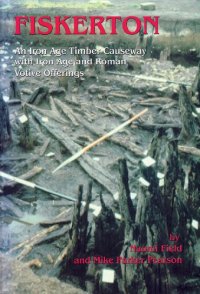
Ebook: Fiskerton. An Iron Age Timber Causeway with Iron Age and Roman Votive Offerings: the 1981 Excavations
- Genre: History // Archaeology
- Year: 2003
- Publisher: Oxbow Books
- City: Oxford
- Language: English
- pdf
With contributions by John Baker, Leo Biek, Don Bramwell, Andrew Chamberlain, Mick Clark, James Cooper, Maggi Darling, Sheila Elsdon, Vanessa Fell, Andrew Fitzpatrick, Alison Goodall, James Greig, Mary Harman, Jennifer Hillam, David Hopkins, J. B. Johnson, Andrew Jones, David Knight, Richard Macphail, Jen Mann, Peter Marshall, J. D. A. Miller, Jacqui Mulville, Sandra Olsen, Peter Osborne, Colin Palmer-Brown, Nicola Smith, Ian Stead, David Taylor, Maisie Taylor, Alison Walster, Jacqui Watson, Colin Whiteman and Jane Young.
Fiskerton, located in the Witham valley of Lincoln, is one of only a handful of excavated sites in Europe to reveal the Iron Age practice of ritually destroying special and elite objects by placing them in a body of water. This volume reports on the 1981 excavations on the bank of the River Witham and provides fascinating insights into this important aspect of Iron Age religion and culture. A remarkable group of Iron Age and Roman artefacts was found in association with a wooden causeway in use from at least 457 to 321BC, including bronze and iron weapons and tools (some decorated with ornamental motifs), bone tools, stone tools, jewellery and pottery. The Iron Age finds are earlier than those from similar watery sites such as La Tène in Switzerland and Llyn Cerrig Bach in Wales, and the precise dating of the Fiskerton causeway by dendrochronology establishes it as one of the earliest known structures in Europe belonging to the La Tène culture. This report provides detailed descriptions of the Iron Age, Roman and Medieval artefacts and the human and animal bones found at the site. The authors compare the Fiskerton evidence with other British, Irish and European examples of ritual or votive deposition in water; they discuss the construction and the appearance of the causeway; and they examine the significance of Fiskerton as a religious site, especially in terms of its topographical context, as a river crossing and as a boundary or liminal area between mainland Britain and the former island of Lindsey.
Fiskerton, located in the Witham valley of Lincoln, is one of only a handful of excavated sites in Europe to reveal the Iron Age practice of ritually destroying special and elite objects by placing them in a body of water. This volume reports on the 1981 excavations on the bank of the River Witham and provides fascinating insights into this important aspect of Iron Age religion and culture. A remarkable group of Iron Age and Roman artefacts was found in association with a wooden causeway in use from at least 457 to 321BC, including bronze and iron weapons and tools (some decorated with ornamental motifs), bone tools, stone tools, jewellery and pottery. The Iron Age finds are earlier than those from similar watery sites such as La Tène in Switzerland and Llyn Cerrig Bach in Wales, and the precise dating of the Fiskerton causeway by dendrochronology establishes it as one of the earliest known structures in Europe belonging to the La Tène culture. This report provides detailed descriptions of the Iron Age, Roman and Medieval artefacts and the human and animal bones found at the site. The authors compare the Fiskerton evidence with other British, Irish and European examples of ritual or votive deposition in water; they discuss the construction and the appearance of the causeway; and they examine the significance of Fiskerton as a religious site, especially in terms of its topographical context, as a river crossing and as a boundary or liminal area between mainland Britain and the former island of Lindsey.
Download the book Fiskerton. An Iron Age Timber Causeway with Iron Age and Roman Votive Offerings: the 1981 Excavations for free or read online
Continue reading on any device:

Last viewed books
Related books
{related-news}
Comments (0)